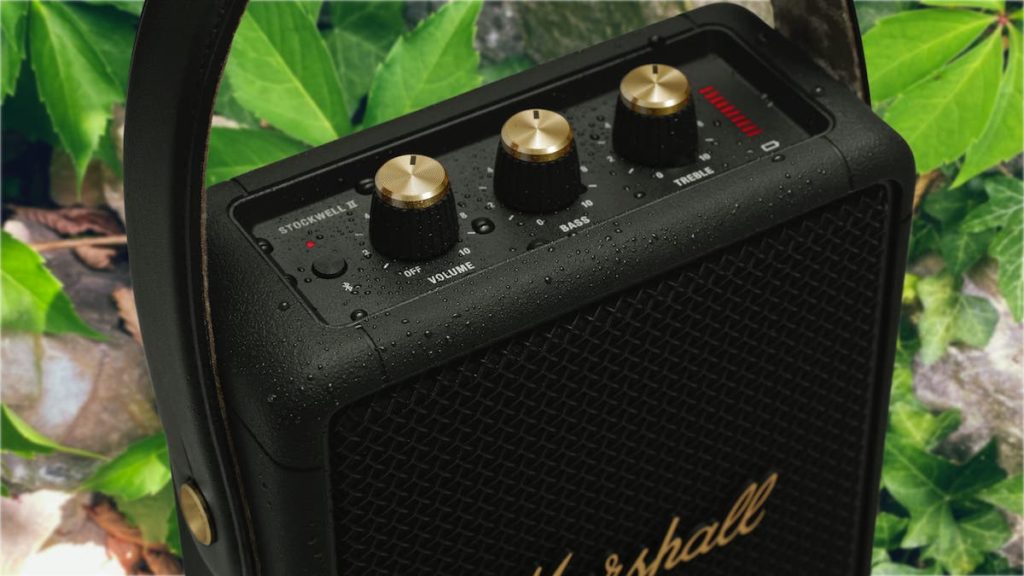Marshall Stockwell II review
The design of Marshall guitar amplifiers has been cult for decades. And rarely have retro products from a manufacturer succeeded so credibly in bringing look and feel to another application area like Bluetooth boxes. This is especially true of the Marshall Stockwell II, which also looks like a scaled-down model of a guitar amp from the front due to its shape and stylish metal grille.
The battery-powered system brings some real advantages over the competition for mobile use: Not only does the case and the oversized carrying strap make a stable impression. The battery life of up to 20 hours and the pleasingly slim case depth of only 7 centimeters also call for outdoor use. You should only be careful with water, because the IPX4 protection class at most forgives splashing water.
Practical and versatile
The impression of having a really well thought-out product in front of you is confirmed when you take a look at the control and connection panel: Three classic rotary controls for switching on, volume and bass/treble dosing are found on top, as well as a detailed battery charge indicator and a Bluetooth pairing button. Music finds its way into the Marshall via Bluetooth 5.0; alternatively, an analog 3.5 mm jack input is available.
The features are limited to what makes sense, but also offer a multi-host function that can keep two smartphones permanently connected. However, the analoge volume control that is not synchronized with the Bluetooth source takes some getting used to. Thus, if you want to fully enjoy the rotary control, you have to turn up the output level on the smartphone to full first. This is essential for maximum sound performance.
Does virtual stereo work out of the small Marshall Stockwell II?
Despite the slim dimensions, Marshall promises a full-fledged stereo system in a Stockwell II. And indeed, two tweeters are installed under the classic grille. However, they are so close together that Marshall electronically adds a virtual base widening, called “True Stereophonic” in the description.
Of course, this assumes that the tweeters each have their own amplifier, and with two times 5 watts, they are really well equipped. Another 10 watts are allotted to the single, central bass-midrange driver, so that the fully active control is here with really power. For bass amplification, Marshall relies on a classic reflex tube instead of an additional passive cone.

This is how the flat Marshall tower sounds
The flat Stockwell II convinced us in the review with its dynamic drive, which was mainly based on a fine and pearly high-frequency resolution. The imaging was rather diffuse, but more convincing than from other very compact virtual stereo systems. It could definitely make powerful music in the mids and trebles and also played decently loud when needed. Voices, however, sometimes lacked fundamental volume; especially outdoors, the Stockwell II showed a tendency towards a rather slim sound.
This also applies to the bass, which supported the impression of a fast and jumpy reproduction, but sounded too slim throughout. There was no real bass balance even when the bass control was turned to the right stop.
The Stockwell II sounded significantly better in our test when it was positioned on a table or shelf in (not too large) rooms. Especially with the support of a near back wall or corner, it gained volume and bass stature. The concept of the virtual stereo image also worked much better with a little help from the acoustics of the room.
Conclusion and alternatives to the Marshall Stockwell II
Those who buy a Marshall often appreciate the very well-made look. Insofar it is difficult to find alternatives for it. The Klipsch Heritage Groove is similarly positioned with an equally lovingly made retro design. It plays bassier and more dynamically, but clearly has to fall behind the Marshall in terms of treble resolution, room imaging and battery life. The bottom line is a clear stalemate, with the Klipsch Outdoor sounding better and the Marshall Indoor playing to its strengths. We would also like to mention the combination of stylish retro design and classy, full-fledged sound: The German Teufel Motiv Go offers an almost unbeatable balance, but is also relatively more expensive and visually more inconspicuous than the Marshall.
Technical data Marshall Stockwell 2
- Manufacturer’s suggested retail price: 169 euros
- Dimensions (W x H x D): 16 x 18 x 7 cm
- Weight: 1,38 kg
- Battery life up to 20 hours
- Special features: IPX4 splash protection, analog input, differential stereo, knob for sound.
- More at: www.marshallheadphones.com
For links on this page STEREO GUIDE may receive a commission from the merchant. This applies, for example, to those marked with *.
Der Beitrag Marshall Stockwell II review erschien zuerst auf stereoguide.com.
stereoguide-referencehometheater-techradar
The very flat and well portable Bluetooth speaker Marshall Stockwell 2 brings a lot of retro feeling, good features and fine sound, but also little bass.
Der Beitrag Marshall Stockwell II review erschien zuerst auf stereoguide.com.